Paleoclimate Information
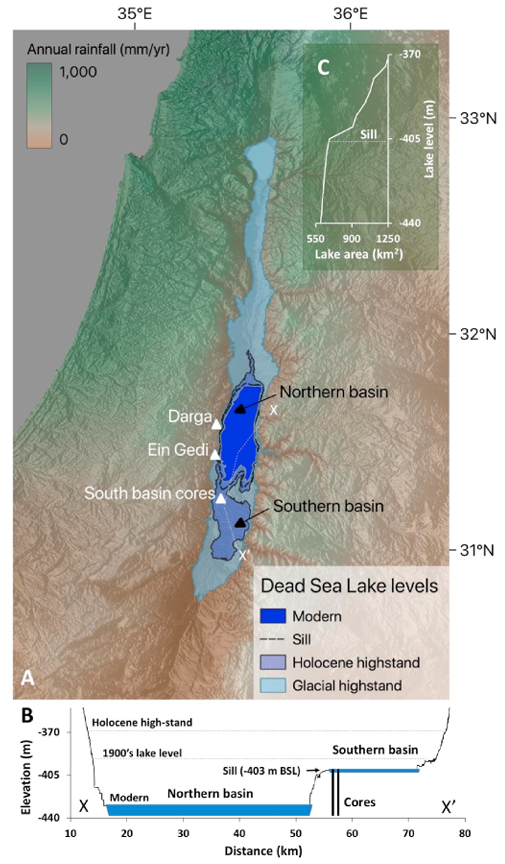
- Dead Sea lake-level status superimposed on relief and rainfall maps and showing the location of the two basins, coring site and highstand Holocene outcrops
- A topographic transect through both basins and the coring location
- An hypsometric curve of the DS, showing that changing lake-level below (above) the sill (403 m bsl) results in a small (large) change in surface area
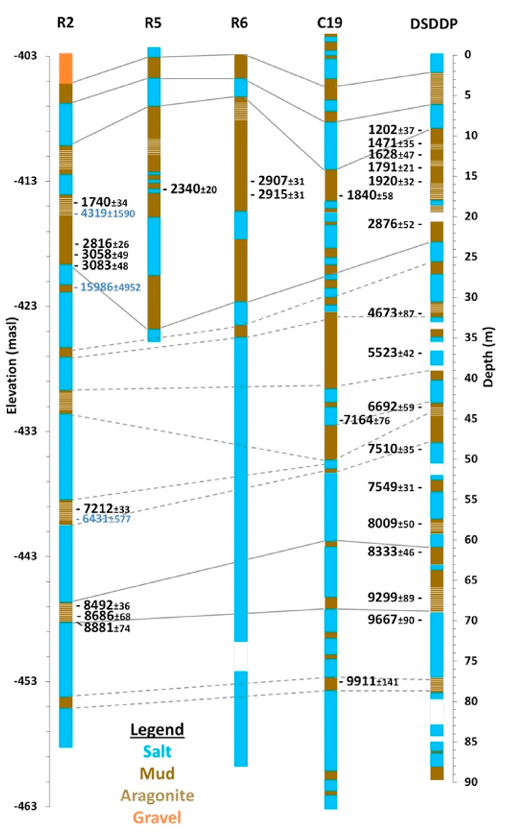 Figure 2
Figure 2Core lithology and chronology. Showing the three DSW cores (R2, R5, R6) we studied, the Charrach (2019) composite record of 25 cores from the central southern basin (C19) and the DSDDP lithology (Kiro et al., 2016; Torfstein et al., 2015) and ages (Kitagawa et al., 2017). The cores are composed of
- halite (blue)
- silty-clay (brown)
- aragonite layers (brown with white lines)
- anthropogenic gravel at the top (orange)
Goldsmith et al. (2023)
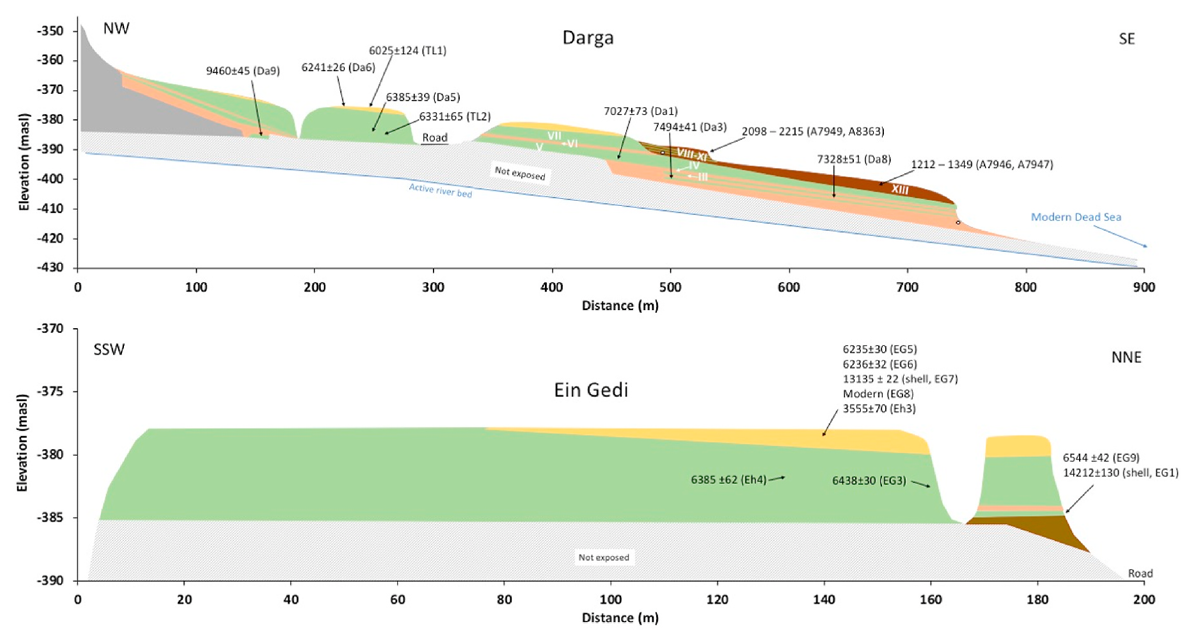
Sedimentary sections of Darga (top) and Ein Gedi (bottom). Darga: The base of the section is composed of sediments of an unknown age (gray), above this unit, on an angular unconformity, are middle Holocene (7.5–6.3 kyr cal BP) thick brown laminated lake sediments (green), with syndepositional beach-ridges (orange) and capped by a middle Holocene (6.2–6.0 kyr cal BP) beach-ridge (yellow). Above the middle Holocene sequence in an angular unconformity with late Holocene beach-ridges (brown) and syndepositional lake sediments (light green) (2.2–1.2 kyr cal BP). Road and bridge landfill sediments and talus (hatched gray lines) extend from the exposure to the active river bed (blue) and obscure the stratigraphy. Original units defined by Kadan (1997) (white roman numerals) and calibrated (yr cal BP) radiocarbon ages (black) from Kadan (1997, A#, where # stands for the sample number), Liu et al. (2013, TL#) and this study (Da#). Units that have more the one sample dated are shown as the calibrated range of the samples (e.g., the younger Darga units). There are two pipes that stick out of the section (black-white circles), these are drawn as geographical markers. Ein Gedi: The base of the section is composed of alluvial gravel (dark orange), above there is a lacustrine unit (green) with a syndepositional alluvial deposit (orange). Above are middle Holocene (6.4–6.3 kyr cal BP) thick brown laminated lake sediments (green). The section is capped by a middle Holocene (6.2 kyr cal BP) beach-ridge (yellow). At the base of the section there is a talus which obscures the lower part of the stratigraphy (hatched gray lines). Calibrated (cal BP) radiocarbon ages (black) are from Bartov (2004, Ehx) and this study (EGx). There are 5 ages from the upper beach-ridge, 2 are from charcoal, one is from a modern chard root and from a melanopsins shell. Bartov’s (2004) age from the beach-ridge (3.6 kyr cal BP) is an outlier, and could be a mixture of the charcoal (6.2 kyr cal BP) and chard root (modern). - Goldsmith et al. (2023)
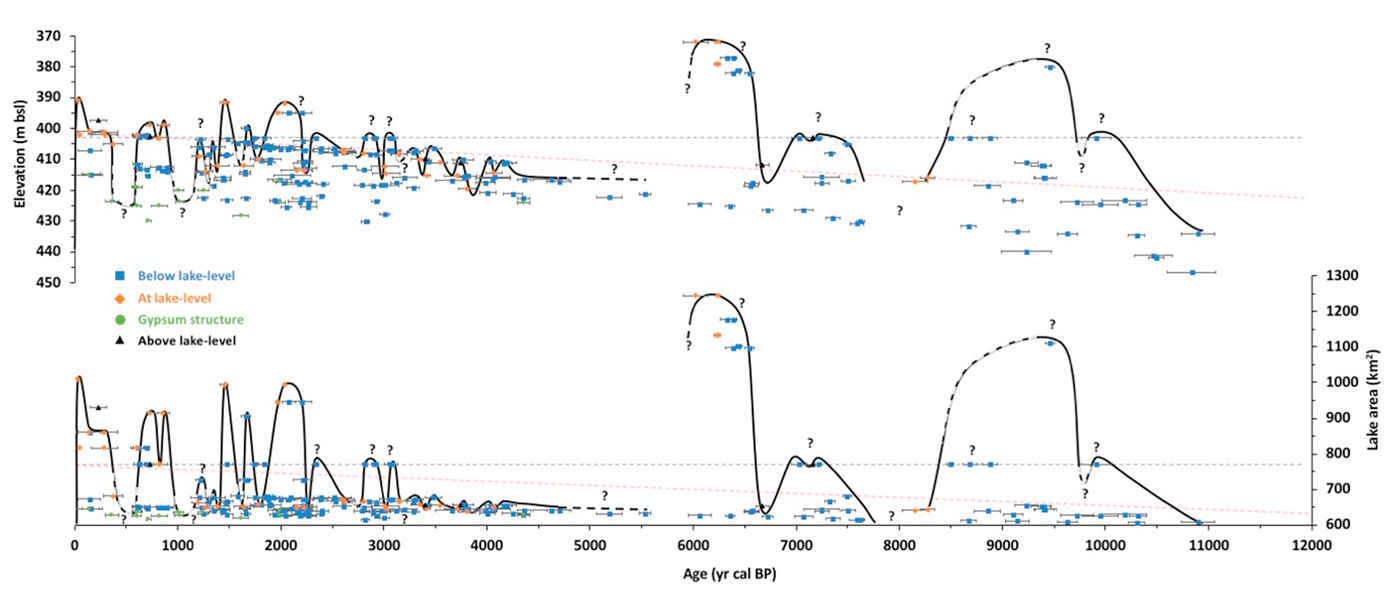
Dead Sea lake-level (top) and lake area (bottom). Dead Sea lake-level indicators
- blue square – below lake-level
- orange diamond – at lake-level
- black triangle – above lake-level
- green circle – gypsum structure
- solid black line for places where the lake-level is well constrained
- dashed lines for places where the lake level is less certain
- Question marks indicate places where the direction of the lake-level is known but the magnitude is not
Goldsmith et al. (2023)
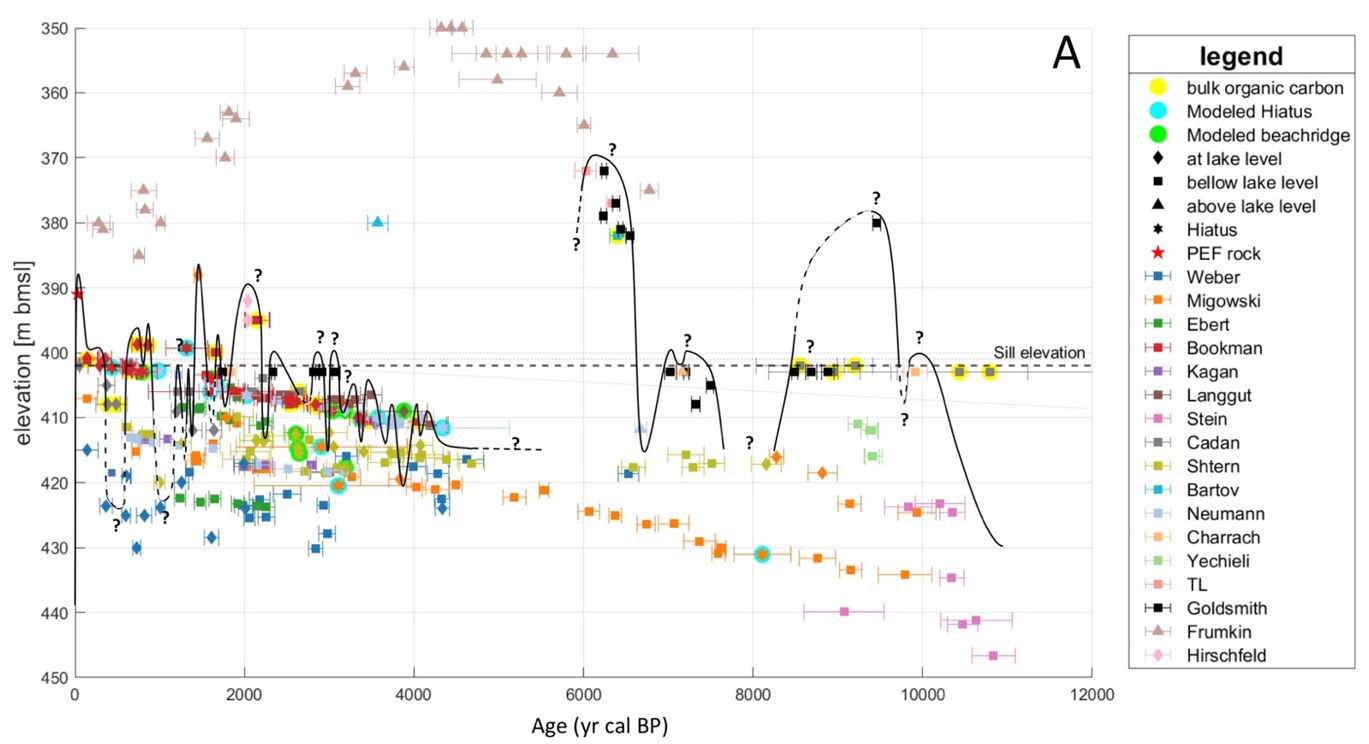
Dead Sea compiled lake-level indicators. This plot contains all radiocarbon dated DS samples (Bookman et al., 2004; Ebert et al., 2021; Enzel et al., 2003, 2000; Frumkin et al., 2001; Kadan, 1997; Kagan et al., 2011; Langgut et al., 2014; Liu et al., 2013; Migowski et al., 2006; Neumann et al., 2007; Stein et al., 2010; Weber et al., 2021). Samples that were dated on bulk sedimentary organics are highlighted in yellow. The ages are calibrated years before present, calibrated using Intcal20 in the Oxcal program (Reimer et al., 2020). Some of the samples come from a single sedimentary deposit and were calibrated as individual samples. Others, are part of a sedimentary sequence that contain a few sedimentary units and have a series of ages and replicate samples. In some sections there are reported hiatuses, their age was evaluated using the “Sequence” option in Oxcal and are highlighted in light blue. Ages of beach-ridges that were reported but not dated directly, were also evaluated using the “Sequence” option in Oxcal and are highlighted in light green. The full database is presented in Table S6.
Goldsmith et al. (2023)
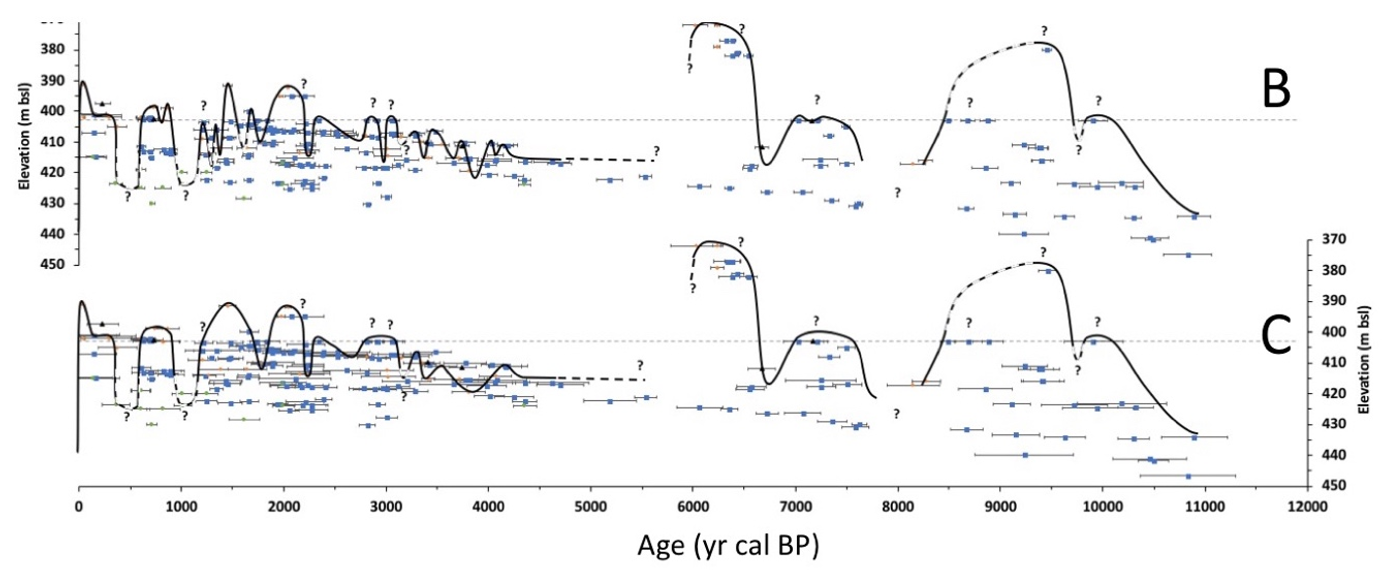
Dead Sea compiled lake-level indicators.
-
Same as Figure 4 in the main text using 1σ uncertainty for the calibrated radiocarbon ages
- blue square – bellow lake-level
- orange diamond – at lake-level
- black triangle – above lake-level
- green circle – gypsum structure
Interpreted lake-level
- solid black line for places where the lake-level is well constrained
- dashed lines for places were the lake level is less certain
- Same as B, for 2σ uncertainty. Using a larger uncertainty reduces some of the rapid lake-level changes and allows for a smoother record.
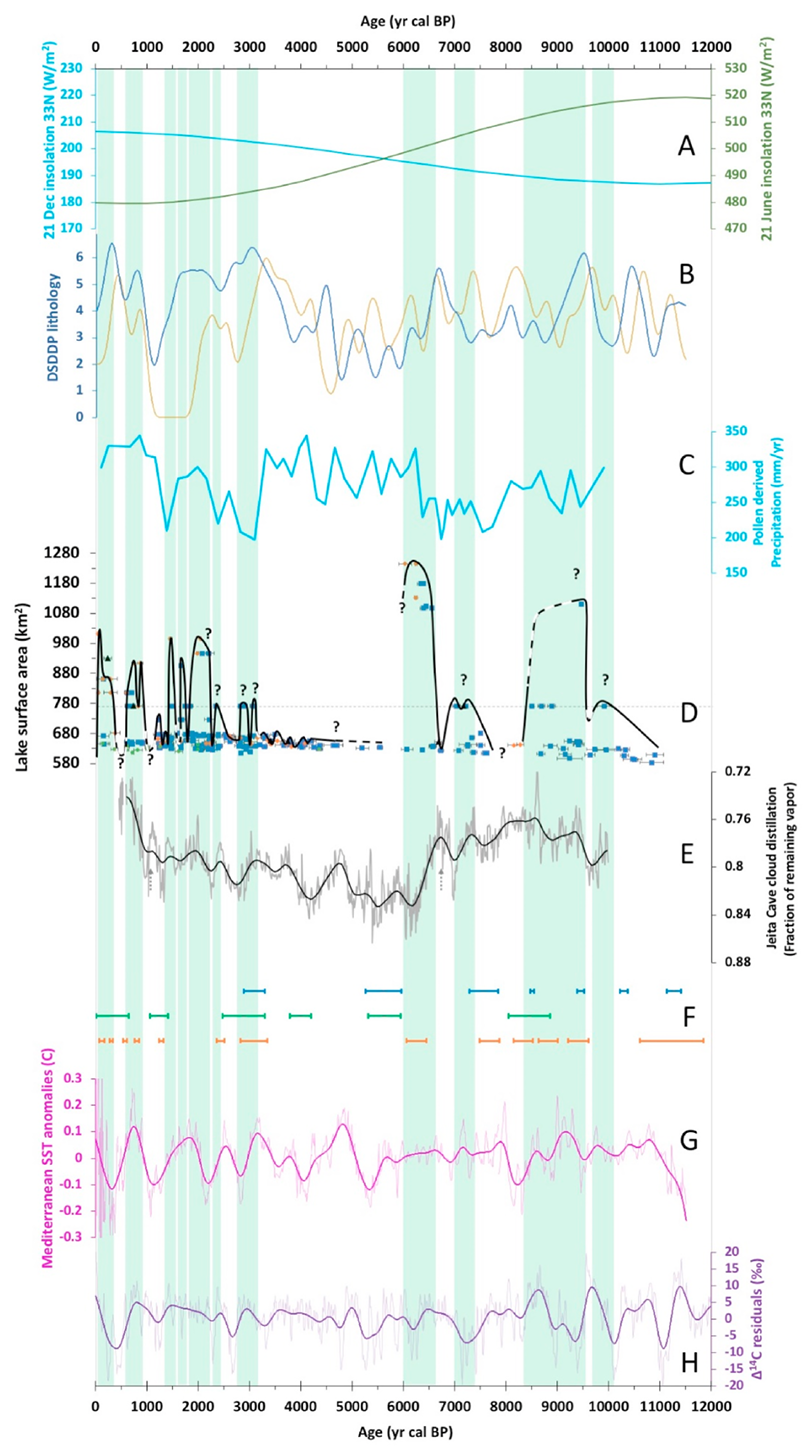
DS lake-level vs. regional and global records.
- Northern Hemisphere insolation at 33ᵒN during summer (green) and winter (blue)(Paillard et al., 1996)
- lithology of the DSDDP core (0 – air, 1 – gravel, 2 – halite, 3 – salty mud, 4 – gypsum, 5 – mud gypsum, 6 - mud, blue line from: Kiro et al., 2016; orange line from: Torfstein et al., 2015). The data was interpolated at 5 year increments and smoothed using a 100 year Gaussian filter. Kiro et al. (2016) created a series of salt sub-categories, for consistency, their li thology was redefined based on the lithological defi nitions of Torfstein et al. (2015)
- Rainfall reconstruction from DS pollen data (Litt et al., 2012)
- DS lake-surface area history, the data and sym bology are the same as in Fig. 4, the lake-area was calculated using the lake hypsometric curve from Fig. 1
- Jeita Cave cloud distillation (gray line) and 50 year Gaussian smooth (black line) (Gonen and Goldsmith, 2023). Gray arrows indicate times where the Jeita record deviates substantially from the DS lake-level
- RCC records: Bond cycle (blue lines, times when hematite stained grains from North Atlantic cores were >15%, Bond et al., 2001), periods of high K+ from GISP2 ice core (green lines, Mayewski et al., 2004), advancement of Alps glaciers (orange, times when Alps glaciers were larger than present, (Ivy-Ochs et al., 2009)
- Mediterranean SST residuals, calculated from the Marriner et al. (2022) data by subtracting the raw data from a 400 year Gaussian smooth of the data, and applying a 100 year Gaussian smooth
- Intcal20 Δ14C residuals (Reimer et al., 2020) calculated by subtracting the raw data from a 400 year Gaussian smooth of the data (after: Stuiver and Braziunas, 1989) and applying a 100 year Gaussian smooth. Time when the lake was above the sill are marked by green vertical bars
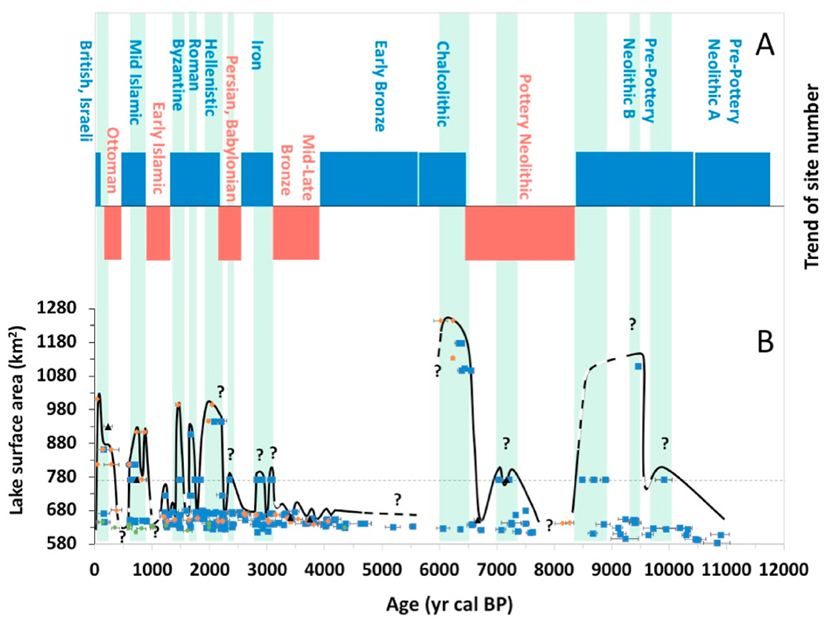 Figure 6
Figure 6DS lake-level data vs. trend of archaeological site number in the Levant.
- The trend of archaeological site number in the Levant (after: Palmisano et al., 2019). For each cultural entity, we evaluate whether the number of sites increased (blue) or decreased (red), in respect to the previous entity.
- Dead Sea lake-level, see Fig. 4 for details
Goldsmith et al. (2023)
The Dead Sea (DS), located in the southern Levant, is a closed-basin lake whose size varies as a function of water availability. Reconstructing DS lake-level variations through time provides a quantitative measure of the natural hydroclimate variability and can inform on the local hydroclimate response to changes in global climate. Here, we constructed an updated lake-level history of the Holocene DS by:
- studying lake high-stands derived from a series of new cores collected in the DS southern basin
- re-dating of the two major Holocene high-stand exposures
- compiling all previously published ages of Holocene DS lake-level markers (n = 296 radiocarbon ages)
The compilation contains 296 radiocarbon ages described in 19 papers and MSc and PhD theses (Fig. 4, Fig. S5 and Table S6). Of these, samples designated as outliers by the original authors (n = 9), dated by bulk organics (n = 9) or older than 12 kyr cal BP (n = 11) and snail samples with a very large reservoirs effect (n = 2) were not used in our lake-level reconstruction. The data derived from the uplifted caves at Mt. Sedom (Frumkin et al., 2001) are not used for the lake-level reconstruction (n = 25), but were previously applied to calculate the uplift rate of Mt. Sedom diapir and constrain the uplift of the late Holocene shoreline at Arubotaim Cave (Frumkin et al., 2001) (Fig. S5 and supplementary text). The final lake-level was reconstructed based on the remaining 238 ages. Of these, 45 are dated beach ridges or samples from near-shore environments, six are from alluvial units, 166 are from lacustrine sediments, and 21 samples are from gypsum structures (Fig. 4). The compilation of all existing lake-level data show that throughout the Holocene, the DS lake-level fluctuated ~68 m (from 440 to 372 m bsl). In Fig. 4, we present the data using the 1σ error of the calibrated ages. The relatively small errors, force, in some places, the lake-level to vary rapidly. Using a 2σ error reduces some of these rapid fluctuations, we present both records for comparison in the supplementary material (Fig. S5).
The compiled lake-level chronology, derived from the 238 radiocarbon ages from lake-margin exposures, southern basin cores, and from shallow cores from the western margin of the DS, provides a detailed history of the hydrological mass balance of the DS watershed and is the most direct and updated hydrological history of the Levant throughout the Holocene (Fig. 4). Additional important information regarding the DS lake status are derived from the deep core drilled into the depocenter of the northern basin and its lithological and geochemical proxies retrieved by the Dead Sea Deep Drilling Project (DSDDP) (Goldstein et al., 2020; Kiro et al., 2020; Kitagawa et al., 2017; Neugebauer et al., 2014; Torfstein et al., 2015). Below, we combine these two sets of records, the levels from the margins and inferences from the core, and provide a hydrological and limnological history of the Holocene DS and discuss its implications.
The early Holocene was characterized by large lake-level fluctuations, where the lake rose and fell substantially (levels ranged from 372 to 420 m bsl). There are two intervals where the lake reached its highest point (9.5 and 6.5–6.1 kyr cal BP). During two additional high-stands (9.9 and 7.5–7.0 kyr cal BP) the lake rose above the sill; the maximum levels associated with them remain unclear. These four high lake-level intervals are evident by four mud deposits in the southern basin, three of which were dated directly from the cores (at depths: 455, 447, 439 mbsl in core R2, Fig. 2), and the youngest, undated mud layer (at a depth of 430 mbsl in core R2, Fig. 2) is most-likely correlated with the dated high-stand sediments in Ein Gedi and Darga (at ~ 375 m bsl). Near-shore deposits at an elevation of ~415 m bsl at 8.1 and 6.7 kyr cal BP indicate that the lake level dropped substantially between these wet phases (Migowski et al., 2006; Neumann et al., 2007, respectively). The reconstructed lake level fluctuations between wet and dry intervals are clearly reflected by silt and halite deposits in the both the DSDDP core and the southern basin cores.
It seems that deposits associated with the 9.5 kyr cal BP high stand have been almost entirely eroded away by the subsequent 6.5 kyr cal BP transgression, which is the highest documented highstand of the entire Holocene at 372 m bsl. Such deposits were, thus far, observed only at one patchy exposure in Darga. It is plausible that additional intervals of high lake-level occurred during the Early Holocene (recorded by mud deposits in the south basin), but evidence for them has been eroded or yet to be recognized. This limits the ability to robustly reconstruct the Early Holocene size of the lake. We reconstructed high lake-levels be tween 9.5 and 8.3 kyr cal BP by tying together three observations:
- the 9.5 kyr cal BP high-stand
- the 8.9–8.5 kyr cal BP mud deposits in the southern basin indicating that the lake level was above the sill
- mud in the depocenter of the lake between 9.6 and 8.3 kyr cal BPs, most probably indicating a prolonged wet interval
From the 6.1–4 kyr cal BP interval there are practically no lake-level indicators from the exposed sediments of the DS. The existing data come from cores along the western margin of the lake recovered from underwater environments (Migowski et al., 2006), and in the later part (since ~4.7 kyr cal BP) also from gypsum deposits in Ein Qedem (Weber et al., 2021), which position the lake-level at around 420 m bsl. In the DSDDP core there are several missing intervals during this time period, which could be related to salt removal during coring, which complicates the ability to assess the lake-status at this time (Fig. 2). In addition, there is a substantial unconformity in Nahal Dagra (Enzel et al., 2000; Kadan, 1997), which current ages constrain between 6 and 2.2 kyr cal BP (Fig. 3). Together, the limited data and unconformity suggest that most probably low lake-levels characterized this time interval. The laminated aragonite layers at 4.6 kyr cal BP in the DSDDP are a possible exception, and likely indicate a somewhat higher lake-level at this time interval. Intriguingly and in contrast to these low levels, the pollen data from the DS shows that the middle Holocene was the wettest of the entire Holocene (Fig. 5)(Litt et al., 2012). This significant discrepancy requires more investigation into effects other than rainfall amount that could be affecting the pollen data.
During the late Holocene, from 4 kyr cal BP onward, the lake-level began rising albeit with fluctuations, and surpassed the sill at ~3.1 kyr cal BP (Fig. 4). This lake-level rise and fluctuations were most likely not as large as those documented for the Early Holocene. The DSDDP (Kiro et al., 2020; Neugebauer et al., 2014; Torfstein et al., 2015), the western margin cores (Migowski et al., 2006), and the southern basin cores all contain alternating mud and aragonite layers during the late Holocene; and indicate the reemergence of the wet conditions during this time period. The Medieval Warm Period (1150–750 yr cal BP, Lamb, 1965; Mann et al., 2009), and Little Ice Age (600–250 yr cal BP, Mann et al., 2009) in the DS are characterized by early dry intervals (1200–900 and 600–350 yr cal BP) followed by late wet intervals (900–600 and 350–100 yr cal BP) (Fig. 3). Thus, the timing and hydrological response do not follow the European climate pattern.
The long-term history of the DS shows that the early and late Holocene were predominantly wet albeit punctuated by dry intervals (Fig. 4). The middle Holocene (6.1–3.6 kyr cal BP) was most likely predominantly dry. Overall, wet conditions prevailed in the Levant during both high (early Holocene) and low (late Holocene) north hemisphere summer insolation and it was dry during the transition from maximum to minimum insolation.
The Levant, a locus of some of the most dramatic cultural changes in human history (e.g. the onset of sedentism, agriculture and urbanization, Bar-Yosef and Belfer-Cohen, 1989; Greenberg, 2019), is located at the northern boundary of the global desert belt, and is characterized by high spatial variability of storms and annual rainfall totals (e.g., Enzel et al., 2008) making it a climatically fragile region (Ellenblum, personal communication). In such a region, small changes in water availability could incur substantial ecological and agricultural changes across the landscape and in turn, cultural responses (Peleg et al., 2012). The DS provides a quantitative hydroclimate record of the Levant and thus can be used to assess the potential role of climate in the region’s cultural evolution. As we are not archaeologists, we will not try to interpret the material culture in light of the hydroclimate reconstruction; however, we would like to evaluate whether there are possible relations between regional water availability and population dynamics.
To assess the history of cultural change in the Levant, we use the results of the archaeological site number database (Palmisano et al., 2019), which contains 20,688 sites of the different cultural entities throughout the Holocene (12–0.5 kyr cal BP)(Fig. 6). We acknowledge that the number of sites is probably not the best metric for evaluating population size because (Drennan et al., 2015):
- it does not account for the size of the sites
- it might be biased towards time intervals that are more highly studied (e.g., the “Biblical Period” of the Iron Age)
- it does not consider the potential destruction of sites through time (i.e., the older the site, the higher the chances it will be destroyed)
- the site number data compiled is based on many surveys that did not use a standardized definition of a “site” (e.g., is a site defined as a scatter of pottery or as a city?), and therefore, the self-consistency is unclear.
 Figure 6
Figure 6DS lake-level data vs. trend of archaeological site number in the Levant.
- The trend of archaeological site number in the Levant (after: Palmisano et al., 2019). For each cultural entity, we evaluate whether the number of sites increased (blue) or decreased (red), in respect to the previous entity.
- Dead Sea lake-level, see Fig. 4 for details
Goldsmith et al. (2023)
The site number trend, qualitatively compared with the DS lake-area (Fig. 6), shows an overall relation. During intervals when the lake is large there is a site increase (during the Pre-pottery Neolithic B, Chalcolithic, Iron, Hellenistic - Roman – Byzantine, Middle Islamic, and British – Israeli) and during intervals when the lake is low there is a site decrease (during the Pottery Neolithic, Persian – Babylonian, Early Islamic and Ottoman). There are also exceptions that do not fit this relation (the Pre-Pottery Neolithic A and the Early Bronze Age). The relation presented, though crude, does suggest potential linkages between population dynamics and hydroclimate variability. More detailed and nuanced information pertaining to temporal leads or lags between the two datasets and a better quantification of both datasets is required to better understand this relation through time.
An additional important observation that is evident from this comparison, regards the collapse of the Late Bronze Age at 3200 years BP, which has been suggested to have been driven by a climatic shift (e.g., Langgut et al., 2014). This suggestion was supported by the DS lake-level record, and in particular the earlier interpretation and dating (of ~3.6 kyr cal BP) of the Ein Gedi high-stand sequence (Bartov, 2004; Langgut et al., 2014; Migowski et al., 2006). Our reevaluation of the ages from the Ein Gedi sequence questions the 3.6 kyr cal BP age (Bartov, 2004), and thus, we did not use this data point. Without this single point, it can be concluded that the lake-level begun rising at 4 kyr cal BP and over topped the sill at 3.1 kyr cal BP. A similar pattern is identified in the Jeita Cave record, where lower distillation characterized the first half of the Late Bronze Age, and a gradual distillation increase occurred throughout the Late Bronze Age and into Iron Age I. Thus, the transition from the Late Bronze Age into Iron Age I in the Levant was characterized by a wetting trend, and not drying.
We reconstructed the DS lake-level changes throughout the Holocene using:
- new data regarding the high-stands of the lake derived from three cores collected in the DS southern basin
- a re-evaluation and dating of the two major Holocene high-stand exposures
- a compilation of all previously dated (n = 296 radiocarbon ages) Holocene DS lake status records.
- The early (10–6.1 kyr cal BP) and late Holocene (3.6–0 kyr cal BP) in the DS were predominantly wet and were also characterized by relatively large lake-level fluctuations, whereas the middle Holocene (6.1–3.6 kyr cal BP) was most likely dry.
- The pattern of dual humid periods in the Holocene is also evident in the Jeita Case distillation record from Lebanon (which represents the integrated magnitude of rainout from the vapor source to the cave). In tandem, these two records provide a quantitative, continuous high-resolution hydrological reconstruction of the Levant throughout the Holocene and indicate that rainfall intensity and total water availability were correlated throughout the Holocene.
- Wet phases in the Levant occurred at times of both high and low summer insolation (early and late Holocene, respectively). This dual humid pattern suggests that there are most likely two different climatic modes that drove these changes. Both dynamic (e.g., shifting of the rain-belts) and/or a thermodynamic (i.e., increased land-sea temperature gradient) mechanisms could have driven these changes. High-resolution transient models are required to tease out these two possible mechanisms.
- There are associations that can be drawn between the DS lake-level fluctuations and cultural transitions in the Levant. These provide a basis for investigating cultural responses to different background climatic conditions.
- The DS lake-level record shows that the natural variability of water availability in the Levant is large, and therefore, this region is highly sensitive to global climatic changes. The predicted future change is of similar magnitude to the natural climate variability and thus, it is crucial to assess whether the anthropogenic drying conditions are in-or out-of phase with the natural climate variability in this region.
- from Bookman et al (2004)
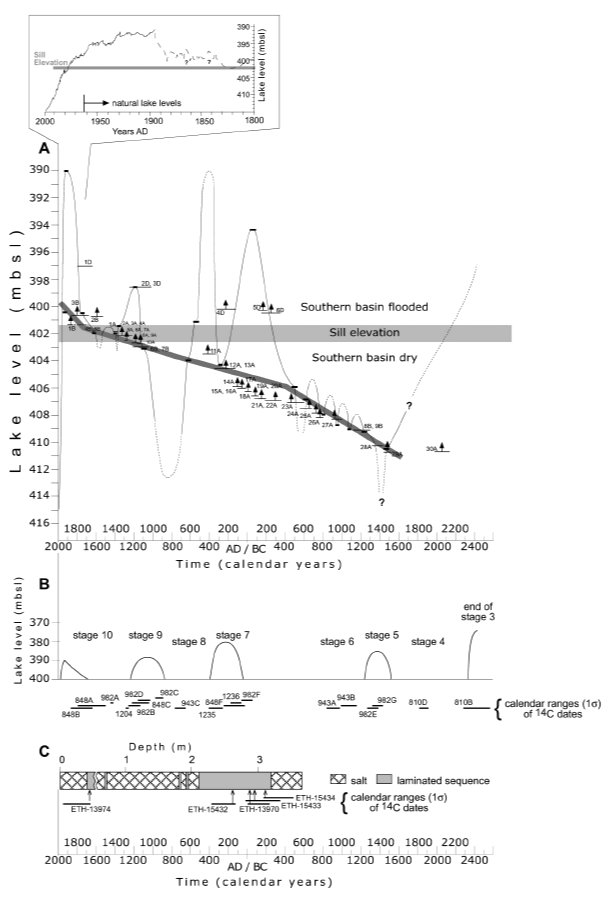
(A) The composite lake-level curve of the Dead Sea during the past 4000 yr. Calibrated radiocarbon dates with 1σ ranges are marked on the curve at the absolute elevation of the samples. Sample numbers marked by A, B, and D are referenced from Table 1 (Ze'elim A site), Table 2 (Ze'elim B site), and Table 3 (David site), respectively. The thick line at the bottom of the curve emphasizes the sediment accumulation at the Ze'elim site (see text). The inset at the top shows the measured historic lake-level curve since A.D. 1800 (modified from Klein, 1986, and extended to the year 2000 by using the Hydrological Service data)
(B) The Dead Sea lake-level curve reconstructed according to Mount Sedom caves (Fig. 1C) and assuming a diapir rising rate of 6 mm/yr (Frumkin, 1997; Frumkin et al., 2001). The radiocarbon dates adjusted to the calendar range are marked with horizontal bars and their sample number (Table 11.1 in Frumkin, 1992)
(C) Core DS 7-1 SC drilled offshore Ein Gedi in the deep northern basin (Fig. 1C). The horizontal extension of the core represents its depth in meters. Calibrated radiocarbon dates are marked with horizontal bars and the sample number (Heim et aL, 1997). Their locations in the core are marked with arrows, and they are adjusted to the calendar range of the Dead Sea curve.
Bookman et al (2004)
- from Kagan et al (2015)
 Figure 4
Figure 4Dead Sea levels during the Bronze and Iron Ages. Lake levels are based on previous works by Bookman (Ken-Tor) et al. (2004) [Ze'elim and Nahal David (Ein Gedi) outcrops], Bartov (2004) [Arugot and Darga outcrops], Migowski et al. (2006) [DS cores], Stern (2010) [Ein Qedem outcrop], Kushnir and Stein (2010)'s interpretation, and on new data (Ze'elim outcrops) and interpretations from this study. References for some specific parts of the curve
- Bartov et al. 2007
- Frumkin et al. 1991; Migowski et al. 2006
- Stern 2010
- this study
- Bartov 2004
- Stern 2010
- beach ridge, this study and Bookman (Ken-Tor) et al. 2004
- Bookman (Ken-Tor) et al. 2004
Kagan et al (2015)
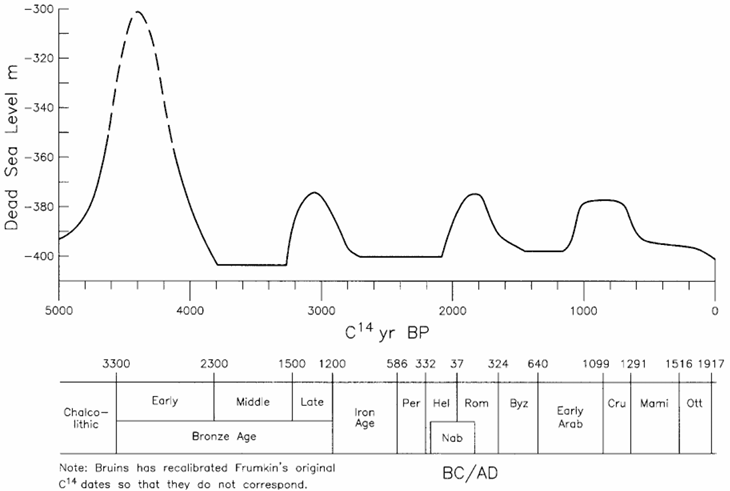 Fig. 2.14
Fig. 2.14Dead Sea level curve proposed by Bruins (1994). This curve shows a lake level high stand during EB II time with water levels being as high as -300 m asl. The curve is based mainly on the previous curve generated by Frumkin (1991).
Rast and Schaub (2003)
- from Hazan et al (2004)
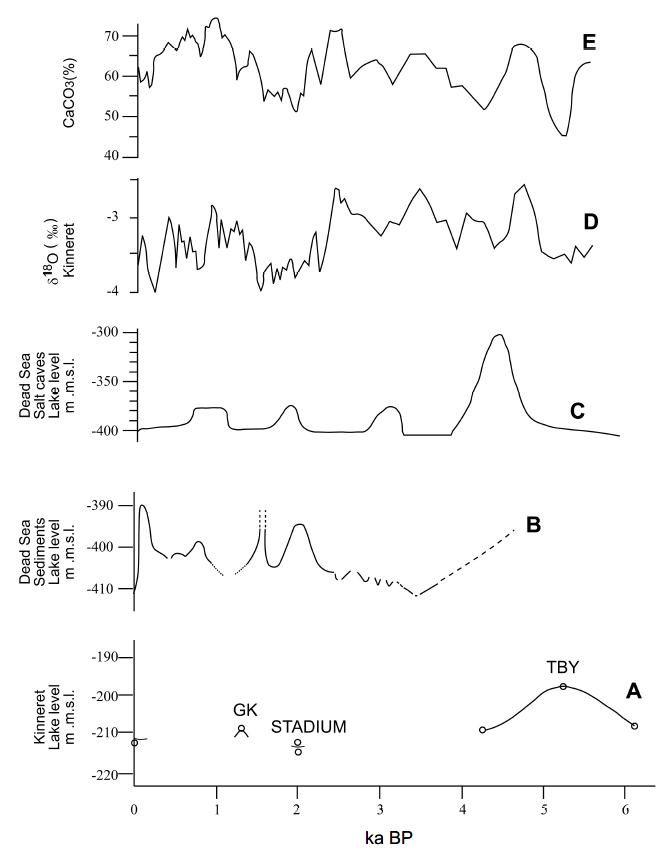 Figure 2
Figure 2Comparison diagrams in the last 6,000 years.
- Kinneret Lake level curve (Hazan, 2003)
- Dead Sea level curve, made from lake sediments (Bookman et al., 2004)
- Dead Sea level curve made from Mt. Sedom salt caves (Frumkin et al., 1991)
- δ18O‰ of carbonate fraction in Lake Kinneret sediments (Stiller et al., 1984)
- % CaCO3 in Lake Kinneret sediments (Stiller et al., 1984)
- TBY = Tel Bet Yerach
- GK = Galei Kinneret
Hazan et al (2004)
- from Hazan et al (2005)

Reconstruction of the Lake Kinneret level curve during the past 40,000 yr. Filled diamonds mark lake level. They were determined by identification of beach sediments and 14C dating (see text). Open squares mark below-lake levels that were evaluated by the location and ages of lacustrine marls. Open circles mark above-lake levels. These points were determined by the occurrence of fluvial sediments and by archeological sites. The numbers on the diagram match those on the location map (Fig. 1) and the description of lake-level reconstruction in the text. During most of the last 40,000 yr, Lake Kinneret level was around 212 m bsl, with some prominent high-stand and low-stand excursions.
The two prominent high stands are:
- at 26,000–24,000 cal yr B.P., lake level reached its highest stand of >174 m bsl and the Kinneret converged with the Southern Lake Lisan.
- At 5200 cal yr B.P., lake level exceeded the altitude of 200 m bsl. The stands are reflected by several gaps in the curve.
- Before 41,000 cal yr B.P.
- between 40,000 and 36,000 cal yr B.P.
- between33,000 and 27,000 cal yr B.P.
- between 14,000 and 10,000 cal yr B.P.
Hazan et al (2005)
- from Hazan et al (2005)
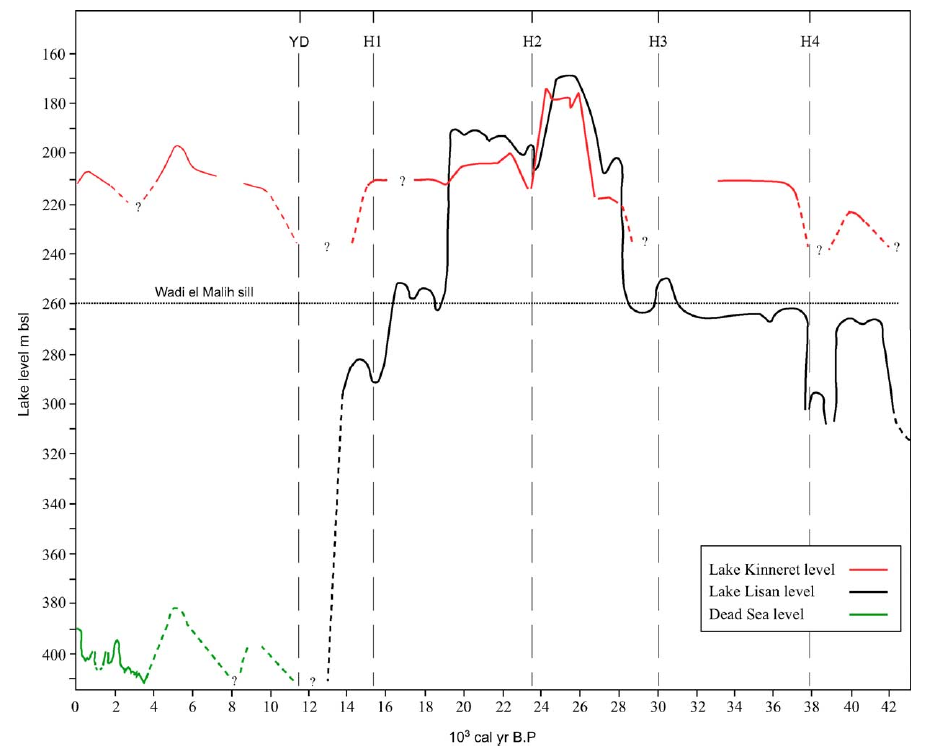
Comparison between Lisan (black), Dead Sea (green), and Kinneret (red) level curves. Note the good agreement between the Lisan and Kinneret curves at periods of high or significantly low stands. Low stands are expressed as hiatuses in the Kinneret curve, and they coincide with the timing of H events in the North Atlantic. The difference between the amplitudes of lake level is significantly larger in the late Pleistocene period (Lisan and Kinneret diagrams) as compared to the Holocene period (Kinneret and Dead Sea diagrams). The Lisan diagram is after Bartov et al. (2003), the Dead sea diagram is after Bookman (Ken-Tor) et al., 2004 and Migowski et al. (2004).
Hazan et al (2005)
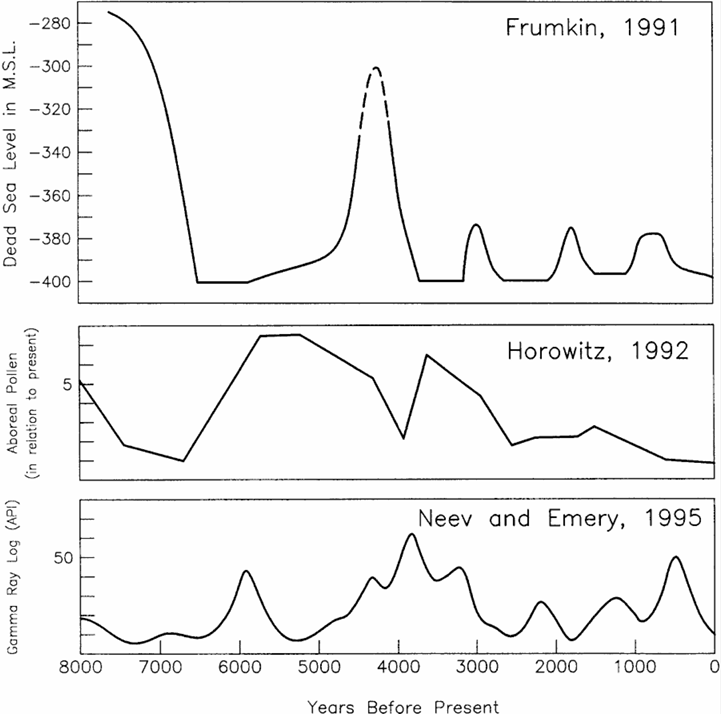 Fig. 2.8
Fig. 2.8Climatic fluctuation as suggested from three different data sets: Frumkin and others (1991), Horowitz (1992), and Neev and Emery (1995).
Rast and Schaub (2003)

Simplified pollen diagram of the Ze’elim composite sequence. A 10-fold exaggeration is used to show changes in low taxa percentages. Chronology and the division into historical periods are based on carbon-14 (14C) dates, calibrated in 2 σ-range. The Carduus-Centaurea group includes thistle taxa Crisium, Carduus, Carthamus, Xanthium and Echinops, and different species of Centaurea. The cereal-type pollen is distinguished from other grasses by its larger size (at least 37 mm; e.g. Beug 2004) and includes wild and cultivated cereals. However, a rise in the cereal curve with no ecological explanation might be connected to agricultural activities. At right: ZA-Pcomp, composite sedimentary profile from two nearby outcrops (FD/ZA3 and ZA2; more details in Kagan et al. 2015). The Late Bronze beach ridge has been reduced to about a third of its thickness for clarity of the pollen diagram. Ages at right of sedimentary section are given in Table 2. Ages for the Middle Bronze period are from Neumann et al. 2007a.
Langgut et al (2014)
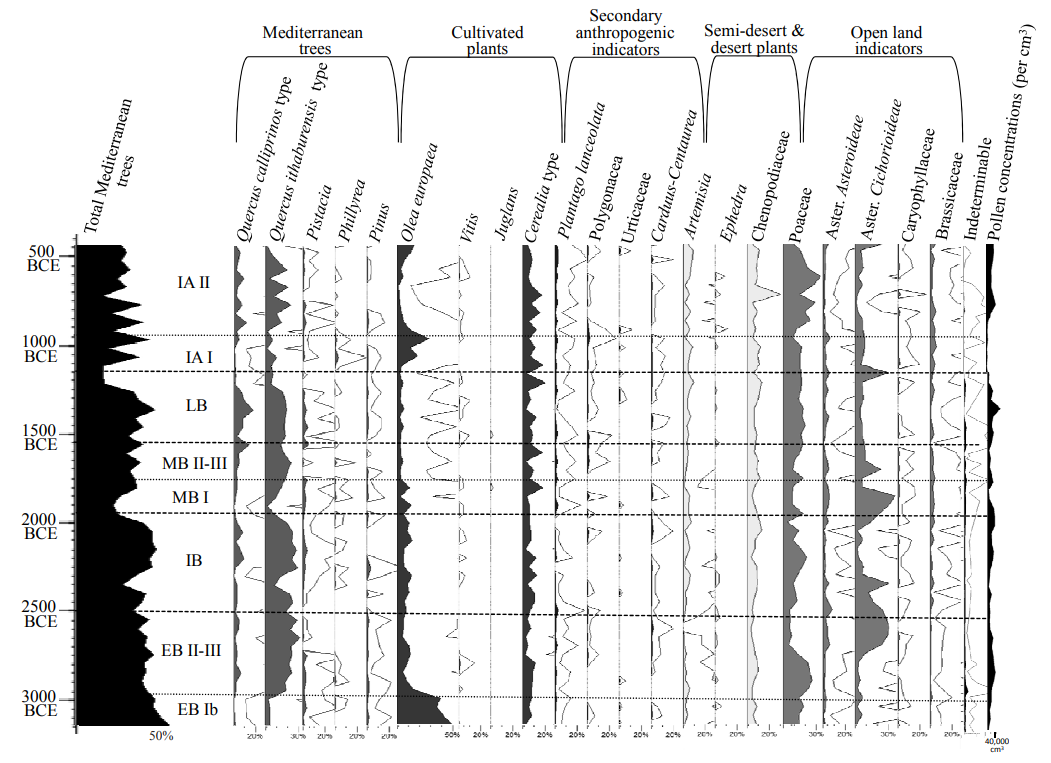 Figure 3
Figure 3Simplified pollen diagram of the Sea of Galilee record during the Bronze and Iron Ages. A 10-fold exaggeration is used to show changes in low taxa percentages. he palynological diagram was divided into five main groups based on taxa geographical origin and on ecological and cultural characteristics (see online Appendix).
- EB = Early Bronze Age
- IB = Intermediate Bronze Age
- MB = Middle Bronze Age
- LB = Late Bronze Age
- IA = Iron Age
Langgut et al (2015)
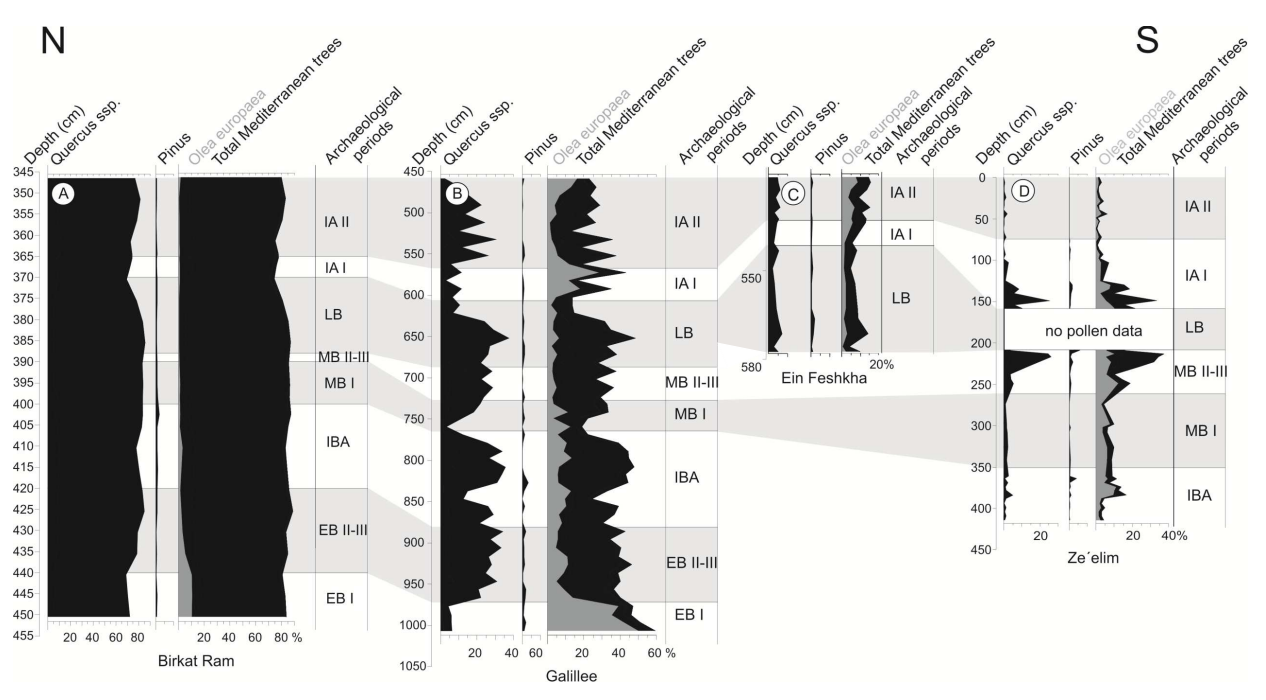 Figure 4
Figure 4A north-south transect of 220 km along the southern Levant during the Bronze and Iron Ages composed of the pollen records from Birkat Ram, Sea of Galilee, Ein Feshkha, and the Ze’elim Gully (references in Figure 1a). Four main pollen curves are given:
- Quercus (oak)
- Pinus halepensis (pine)
- Olea europaea (olive)
- total tree pollen of the Mediterranean maquis/forest
Langgut et al (2015)
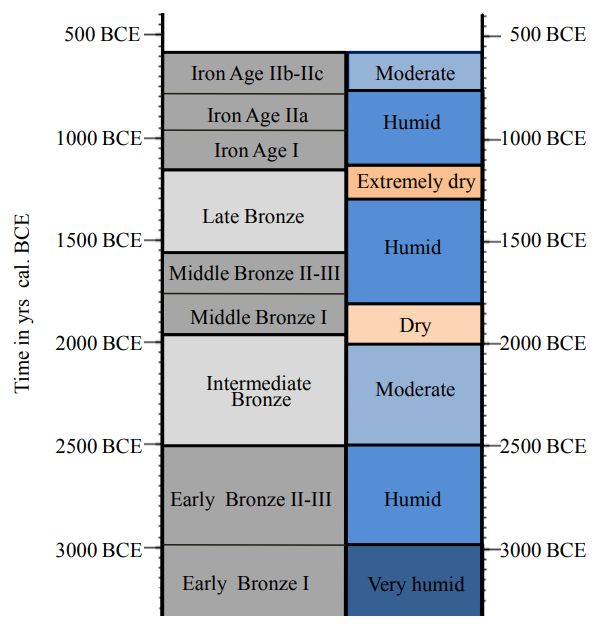 Figure 5
Figure 5Summary of the climate history of the southern Levant during the Bronze and Iron Ages based on the palynological evidence
Langgut et al (2015)
Two palynological diagrams are available for this period (Fig. 1.3a,b)––Birkat Ram and the Sea of Galilee (the latter begins in ca. 3150 BCE, corresponding to the later phase of the period). The Mediterranean arboreal pollen curve, including olive trees, appears at its highest percentages, indicating that the Early Bronze I was the most humid phase of the Bronze and Iron Ages. Relatively wet climate conditions are similarly evident from the Sorek Cave isotopic record (Bar-Matthews and Ayalon 2011: Fig. 6) as well as from the Jezreel Valley geoarchaeological data (Rosen 2006: 468–469; Adams et al. 2014). Wet climate conditions in the Early Bronze I may have facilitated the initial phase of the wave of settlement in the Negev Highlands (for the chronology, see Avner and Carmi 2001; Sebbane et al. 1993). The picture is similar in the semi-arid regions of Transjordan, which feature more Early Bronze I than Early Bronze II–III sites (Philip 2008: 189; Bradbury et al. 2014: 211–214).
The Early Bronze I also features the highest frequencies of olive trees (at Birkat Ram ca. 10% and in the area of the Sea of Galilee up to 50% of the total pollen sum), representing the development of a specialized economy focused on olive orchards and their secondary products (Neumann et al. 2007b; Langgut et al. 2015; Langgut, Adams and Finkelstein 2016). In the En-Gedi palynological record (mainly representing the situation in the Judean Highlands; Litt et al. 2012), high olive percentages were also documented, indicating that during the Early Bronze I large scale olive horticulture activity took place in the entire Mediterranean zone of the Southern Levant. Archaeobotanical evidence from excavations indicates that olive wood was exploited at a remarkably high level in this specific period (Benzaquen, Finkelstein and Langgut 2019, and see also the review of evidence in Genz 2003). As olive yields benefit more from an even pattern of rainy days over a long period of time than from rains that fall in sudden torrents (as is the situation today in the region), the high arboreal and olive pollen frequencies may reflect a different rain regime (Langgut, Adams and Finkelstein 2016). A similar suggestion was raised by Rosen (1991: 197) based on her study in the Lachish area.
Olive grows best in its original natural habitat in hilly Mediterranean zones; it is no wonder then, that this period is characterized by large-scale settlement expansion into the hill country on both sides of the Jordan (Finkelstein and Gophna 1993; Finkelstein et al. 2006; Bradbury et al. 2014; Langgut, Adams and Finkelstein 2016: Table 2). Many of the new highland settlements were located in the orchard niches of western Samaria (for the situation in the early 20th century CE, see distribution map of olive orchards in Palestine, 1935, available in Finkelstein and Langgut 2018: Fig. 4). Considering the intensity of olive growth in this period as indicated in the pollen records, olives and their oil must have been produced in quantities beyond local consumption as a “cash crop” (Langgut, Adams and Finkelstein 2016). Evidence from the southern Coastal Plain and the Nile Delta attest to strong trade relations with Egypt; secondary products of the highlands’ olive horticulture activity must have played a major role in this network (e.g., Finkelstein and Gophna 1993; Braun 2002). Indeed, commercial contacts during the Early Bronze I are evident from material culture items found in both the Levant and Egypt (Braun 2002; de Miroschedji 2002; Sowada 2009). Egyptian demand for Southern Levantine goods during the Early Bronze IB (Naqada IIB–IIIC1; 3500– 3000 BCE) must have accelerated the expansion of the settlement system into the hill country, intensified production in the olive orchards, encouraged the development of Egyptian marketing stations along the southern Coastal Plain (in Naqada IIIC1) and stimulated the growth of social and political complexity in the Southern Levant (Finkelstein and Gophna 1993; de Miroschedji 2002; 2009; Regev et al. 2014; Langgut, Adams and Finkelstein 2016).
The high olive pollen frequencies that characterize the Early Bronze I were followed by a dramatic decline in olive pollen percentages during the transition to the Early Bronze II, as is evident in the Birkat Ram and especially the Sea of Galilee pollen records (from a peak of more than 50% to a low of only 5% of the total pollen sum; Fig. 1.3a–b). Decreased olive pollen frequencies around 2900 BCE were also documented in the Lake Ḥula record (van Zeist, Baruch and Bottema 2009: Fig. 5).
A slight reduction in the arboreal vegetation was recorded in the Early Bronze II (from a range of 46.1– 59.5% to 36.5–40.4% in the Sea of Galilee record for example), which might signal a minor shrinkage of the natural Mediterranean forest/maquis. Still, relatively humid climate conditions continued to prevail in the region, as is also evident by the Sorek Cave isotopic record (Bar-Matthews and Ayalon 2011: Fig. 6; Laugomer 2017). Reconstruction of the Dead Sea levels shows high stands during the Early Bronze II (lake levels reached 385 m below msl—Migowski et al. 2006: Fig. 3), indicating wet climate conditions not only in the area of the lake, but also in the northern parts of its drainage basin (for the drainage basin of the two lakes, see Fig. 1.1a). Continued wet climate conditions were especially significant for the marginal regions of the Southern Levant in the south and east. In the Early Bronze II, the wave of settlement in the Negev Highlands peaked (Cohen 1999) and the town at Arad in the Beersheba Valley reached its zenith, probably becoming a gateway community for southern trade (Finkelstein 1991; Finkelstein et al. 2018 and references therein).5
The Early Bronze I/II transition ca. 3000 BCE witnessed significant change in the organization of society and the distribution of settlements in the Southern Levant, which seems to be unrelated to climate conditions, but rather to territorio-political or economic circumstances (Langgut et al. 2015; Langgut, Adams and Finkelstein 2016; Laugomer 2017). The decline in olive pollen (Fig. 1.3a–b) was also probably linked to changes in geopolitical (rather than climatic) conditions in the region. Based on the archaeological evidence, overland transportation between the Southern Levant and Egypt had waned, while maritime links between Egypt and the northern Levant were intensified (Marcus 2002). This explains the decline in settlement activity across northern Sinai, which served as the 5. In addition to the Mediterranean climate system, precipitation in these regions is influenced by the Red Sea Trough. 6. The differences between the pollen and the isotopic records lay only within the fluctuations of the general trends, since both records point to relatively humid climate conditions. The slight discrepancies may derive from differences in sampling resolution (the Sorek Cave record was sampled at a higher resolution), and/or differences within the dating methods (14C versus Uranium-Thorium). They may also be related to the slower response of the vegetation in comparison to the more sensitive isotopic proxy. overland route between Egypt and the Levant. Botanical and archaeological data from the northern Levant corroborates this picture (Langgut, Adams and Finkelstein 2016 and references therein). In general, the Southern and Northern Levant olive pollen curves show a “mirror image” throughout the Bronze and Iron Ages, reflecting shifts in balance between the two regions from which olive oil was exported, mainly to Egypt (Fig. 1.4).
5. In addition to the Mediterranean climate system, precipitation in these regions is influenced by the Red Sea Trough
Based on the Sea of Galilee pollen record, the Early Bronze III is also characterized by relatively high arboreal percentages (reaching up to 46.2%), indicating the continuity of relatively wet climate conditions. The minor increase in oak pollen documented in the Birkat Ram and Sea of Galilee records signals a slight expansion of the natural Mediterranean forest/maquis (Fig. 1.3a). The Sorek Cave isotopic record also indicates humid climate conditions in the region, with estimated annual rainfall above 520 mm (the mean annual rainfall today; Bar-Matthews and Ayalon 2004 2011), though a slight gradual decline was documented over the course of this period.6 The Olea pollen values retain their low frequencies. Still, in the Sea of Galilee record slightly higher olive pollen percentages were recorded in the early phase of this period (ca. 2900– 2650 BCE) in comparison to the later phase (ca. 2650–2500 BCE), reaching maximum of olive pollen values of 11.3% versus 5.4% (of the total pollen sum) respectively. This means that neither the decline in the number of sites in the central hill country nor the southward expansion of urban settlement in the lowlands were climate-related (Langgut, Adams and Finkelstein 2016: Table 2). New radiocarbon dates and other lines of evidence from the copper mining districts in the Arabah, the Negev Highlands and Arad also reveal activity in the arid regions during the Early Bronze III, contra previous theories (Ben Yosef et al. 2016; Finkelstein et al. 2018). While the wet climate conditions which are reconstructed for this period may have facilitated activity in the arid lands of the Southern Levant, it seems that other factors were more influential, first and foremost the demand for copper in Egypt (Finkelstein et al. 2018).
6. The differences between the pollen and the isotopic records lay only within the fluctuations of the general trends, since both records point to relatively humid climate conditions. The slight discrepancies may derive from differences in sampling resolution (the Sorek Cave record was sampled at a higher resolution), and/or differences within the dating methods (14C versus Uranium-Thorium). They may also be related to the slower response of the vegetation in comparison to the more sensitive isotopic proxy.
At both Birkat Ram and the Sea of Galilee, this period shows no major change in the distribution of the Mediterranean arboreal vegetation (Figs. 1.3a–b). Therefore, it seems that the crisis in the urban system, which started at the end of the Early Bronze Age (ca. 2500 BCE; Regev et al. 2012) and lasted through the entire Intermediate Bronze Age, was not a result of climate change. Yet, two short events pointing to drier conditions were recorded: at ca. 2350 BCE (based on the Sea of Galilee record) and at the end of the Intermediate Bronze/beginning of the Middle Bronze I (Sea of Galilee and Zeʾelim; Fig. 1.3b,d; Langgut et al. 2015). These dry events were also documented by the declining level of the Dead Sea (Kagan et al. 2015). The latter dry event was also identified in the new pollen record from Tel Dan (Kaniewski et al. 2017). The Intermediate Bronze Age features evidence for strong settlement activity in the Negev Highlands (Cohen 1999; Dunseth et al. 2017), which was related to the copper industry in the Arabah Valley south of the Dead Sea (Ben-Yosef et al. 2016; Finkelstein et al. 2018). The humid climate conditions did not stimulate dry farming in the region but could have supported pastoral nomadic activity (Rosen 2017; Dunseth, Finkelstein and Shahack-Gross 2018). The cessation of activity in the region during the middle of the Intermediate Bronze Age, ~2300–2200 BCE, is probably related to diminishing demand for copper as a result of the decline of the Old Kingdom in Egypt (Finkelstein et al., 2018).
The Intermediate Bronze Age is a period traditionally associated with a more pastoral mode of subsistence in the Southern Levant. However, the northern pollen records (Birkat Ram and the Sea of Galilee) indicate that no major shift took place in human exploitation of the environment, that is, olives were probably still cultivated to the same extent as during the previous period—the Early Bronze II–III.7
More arid conditions at the end of the Intermediate Bronze Age are also evident in the lithology of the Zeʾelim section, which points to accumulation of sediments in a shore environment (sands and a thin beach ridge were deposited from ca. 2000 to 1800 BCE; Langgut et al. 2014; Kagan et al. 2015). Drier climate conditions were also documented in: 1) other Southern Levant pollen records (Litt et al. 2012; Kaniewski et al. 2017); 2) declining level of the Dead Sea (from 380 m below msl to 400 m below msl; yet, the drop began slightly earlier ca. 2200/2100 BCE and lasted about 200–300 years) (Migowski et al. 2006; Kagan et al. 2015); 3) isotopic composition of tamarisk wood from the Mount Sedom Cave (southern Dead Sea), which points to a prolonged drought (of more than 100 years) at the end of the Intermediate Bronze Age (Frumkin 2009); as well as the Sorek Cave speleothems isotopic record, which indicates a decrease in precipitation during ~2200–1900 BCE (Bar-Matthews and Ayalon 2004, 2011; Laugomer 2017). The magnitude and duration of the event (within each respective profile) is more or less similar; these observations suggest a regional event rather than a localized one. Indeed, this dry episode was also identified in isotopic records from northern parts of the eastern Mediterranean (Finné et al. 2017; Kaniewski et al. 2018).
7. Since Olea pollen production has a strong response to cessation of cultivation (a dramatic decrease in pollen production was documented in deserted orchards after several decades of abandonment—Langgut, Lev-Yadun and Finkelstein 2014), the olive pollen that was identified during the Intermediate Bronze Age represents well-maintained orchards.
During the Middle Bronze I, olive tree percentages appear at the same magnitude as in the Intermediate Bronze Age in both records (Sea of Galilee and Zeʾelim), representing olive production likely sufficient only for local consumption From the beginning of the period until about 1800 BCE, Mediterranean tree values remain low. It seems that the dry period that began at the end of the Intermediate Bronze Age lasted about two centuries (ca. 2100–1800 BCE). Based on other paleoclimate records already mentioned, this event may have lasted slightly longer—about 300–400 years, between 2200–1800 BCE (Langgut et al. 2015; Laugomer 2017). Can this dry event be associated with the much discussed 4.2 BP event, suggested by Weiss et al. (1993; Weiss 2012; 2017) as the region-wide “mega-drought” that brought about the collapse of the Akkadian Empire (see critique in, e.g., Wanner et al. 2008; Finné et al. 2011)? The answer is that climatic proxies of the Southern Levant cannot be easily projected onto Mesopotamia, at the very least because the latter is influenced by parameters other than just the Mediterranean climate system (Finkelstein and Langgut 2014 and references therein).
The ca. 2100–1800 BCE dry phase may explain changes in settlement patterns in the entire Levant and beyond, from the Beersheba Valley in the south (Fig. 1.5) to the upper Euphrates in the north. These include withdrawal of permanent settlement activity from semi-arid zones in southern Canaan and a demographic low in steppe zones in the north, such as the Beqaa Valley of Lebanon and the Jezirah. These were the result of the shift in the 400 mm rainfall isohyet (marking the boundary between the Mediterranean and Irano-Turanian vegetation zones), to the north and to the west. For this reason, significant numbers of people may have moved to “greener” parts of the Levant (Finkelstein and Langgut 2014). This dry phase in the Levant could have been one of the reasons for the beginning of Asiatic settlement in the northeastern Nile Delta during the 19th century BCE (ibid.).
Based on the three pollen records available for the Middle Bronze II‒III (Birkat Ram, Sea of Galilee and Zeʾelim; Fig. 1.3), wetter climate conditions, which are recognized by the increasing percentages in Mediterranean trees around 1800 BCE, prevailed throughout this period (Langgut et al. 2015), in comparison to the previous period. During this timespan the Zeʾelim sediments accumulated in a lacustrine environment, representing an increase in Dead Sea levels and more humid conditions (as opposed to the beginning of Middle Bronze I, when sediments accumulated in a shore environment; Langgut et al. 2014; Kagan et al. 2015). Indeed, according to the reconstruction of the Dead Sea levels, it was in the Middle Bronze II–III, that the lake reached its highest level during the last four millennia—up to 370 m bmsl (Migowski et al. 2006; Kushnir and Stein 2010).
The archaeological evidence points to an increase in settlement activity in the central highlands during the Middle Bronze II–III (Finkelstein 1995; Ofer 1994). Along the coast, the wetter climate conditions of the Middle Bronze II–III that followed the dry phase seem to have enabled the settlement system to recover and re-expand southward into the Naḥal Besor area and the Beersheba Valley (e.g., Finkelstein et al., 2018). Settlement of Asiatics in the Nile Delta continued and intensified—this time mainly for economic reasons (Finkelstein and Langgut 2014).
According to the northern pollen diagrams (Birkat Ram and Sea of Galilee; Figs. 1.3a, b) during the beginning of the period, the Mediterranean arboreal pollen percentages remain relatively high, representing continuity of a well-developed Mediterranean forest/ maquis. The ʿEin Feshkha record begins in the middle of the Late Bronze Age; it exhibits high values for arboreal pollen, which decline toward the end of the period, reflecting drier climate conditions (Fig. 1.3c). No pollen data for the Late Bronze Age is available from the Zeʾelim record (Fig. 1.3d) due to sedimentary erosion and unfavorable conditions for pollen preservation in sandy sediments (Langgut et al. 2014; 2015).
During the 14th century BCE, ca. 1350 BCE, high frequencies of Mediterranean pollen trees were recorded in the Sea of Galilee pollen diagram, which most likely indicate relatively wet climate conditions (Fig. 1.3b); this is consistent with the fact that the Amarna tablets,dated to ca. 1360–1330/35 BCE, do not mention droughts or famine in the region. Yet, the values of olive pollen remain in their low frequencies, indicating a limited spread of olive horticulture (Figs. 1.3a–c). The En-Gedi palynological record (Litt et al. 2012) is consistent with this picture.
The Late Bronze Age was marked by a dramatic decrease in settlement activity in the hill country of the Galilee, Samaria and Judea (Bunimovitz 1994; Ofer 1994; Finkelstein 1995). The relatively high percentages of the arboreal pollen indicate that in much of the period the settlement crisis was man-induced rather than a result of a climate change.
According to all four pollen records, the most striking feature in the Bronze and Iron Age pollen transect appeared at the end of the Late Bronze Age. This phase is characterized by extremely low arboreal vegetation percentages (for both Mediterranean trees and olive trees) in the Sea of Galilee and ʿEin Feshkha, while in the less-sensitive Birkat Ram record only a slight reduction in arboreal pollen was documented. Based on the En-Gedi (Litt et al. 2012) and Sea of Galilee pollen records, the beginning of decline in Mediterranean elements can be dated to the mid-13th century BCE. The dryness is also made evident by a dramatic drop in the Dead Sea levels (Kagan et al. 2015). Litt et al. (2012) report that around 1300 BCE a thick sand unit accumulated in the En-Gedi core while Neumann et al. (2007a) describe a sedimentological unconformity in the ʿEin Feshkha record at about the same time. In the Zeʾelim Gully, a beach ridge was deposited in a shore environment around 1200 BCE (Langgut et al. 2014; Kagan et al. 2015). The occurrence of a shore depositional environment in these western Dead Sea margin sites represents a drop in the Dead Sea lake levels that was most likely the result of reduced precipitation, primarily in the area of the northern sources of the Dead Sea drainage basin. Low settlement activity at that time indicates that the shrinkage of the Mediterranean forest was most likely the result of climate rather than man-induced change (Langgut et al. 2015).
Severe dryness during the end of the Late Bronze Age and into the Iron I transition was identified in three other high-resolution palynological profiles from nearby regions: the northern Syrian coast (Kaniewski et al. 2010), Cyprus (Kaniewski et al. 2013) and the Nile Delta (Bernhardt, Horton and Stanly 2012). A dry event is also observable in eastern Mediterranean isotopic records (e.g., Finné et al. 2017). This data suggests that the dry spell at the end of the Late Bronze Age took place across a vast geographical area (Langgut, Finkelstein and Litt 2013; Kaniewski et al. 2015 and references therein; Langgut et al. 2015).
Harsh long-term droughts may have been the prime mover, then, for the collapse in the eastern Mediterranean basin during the “crisis years” at the end of the Bronze Age (Carpenter 1966; Weiss 1982; Neumann and Parpola 1987; Alpert and Neumann 1989; Ward and Joukowsky 1992; Issar 1998). Destruction layers at Levantine sites seem to indicate that the crisis in the eastern Mediterranean took place from the mid-13th century until the end of the 12th century BCE—during the same time interval when drier climate conditions were prevalent in the region. In the Levant, the crisis years are represented by the destruction of urban centers, shrinkage of other major sites, hoarding activities and changes in settlement patterns. Textual evidence from several places in the Ancient Near East attests to drought and famine starting in the mid-13th century BCE and continuing until the second half of the 12th century BCE (Astour 1965; Klengel 1974: 170‒174; Naʾaman 1994: 243‒245; Zaccagnini 1995; Singer 1999: 715‒719; 2000; 2009: 99; Cohen 2021).
All four pollen records for the Iron I show an increase in oak, total Mediterranean trees and olive pollen percentages. In the Birkat Ram record, where only two samples fall within the Iron I, a minor increase of Mediterranean tree pollen is visible in the transition from the previous period (Fig. 1.3a). In the Sea of Galilee record, a significant Olea pollen peak is notable; a similar peak appears in the ʿEin Feshkha and Zeʾelim pollen diagrams, together with a rise in oak pollen (Fig. 1.3b,d). As a result of the increase in moisture following the severe dryness at the end of the Late Bronze Age, both the Mediterranean forest/maquis and olive orchards expanded (Langgut et al. 2015). This is also evident in the En-Gedi pollen record starting from ca. 1000 BCE (Litt et al. 2012).
The improved climate conditions during the Iron I enabled the recovery of settlement activity. This is demonstrated by the revival of the urban system in the northern valleys (Finkelstein 2003) and in the settlement wave which took place in the highlands, including areas which are amenable to olive cultivation (Gal 1992; Finkelstein 1995; Frankel et al. 2001; Zertal 2004, 2007). The growth of settlement activity in the highlands is the backdrop for the rise of Ancient Israel and other Iron Age groups—the Arameans, Ammonites and Moabites (Finkelstein 1995; Joffe 2002). Especially noteworthy are settlement developments on the margin of the settled lands: the spread of activity in the Beersheba Valley (Herzog 1994), the rise of an early Moabite territorial polity south of the Arnon River (Finkelstein and Lipschits, 2011) and the appearance of Iron I sites on the Edomite Plateau (Finkelstein 1992). Wetter climate conditions than what we see in the arid region today could have helped the daily subsistence economy, which was probably based on dry farming and herding. Copper mining in the Wadi Faynan area (for Khirbet en-Naḥas, see Levy et al. 2004; 2008) would have likely been made easier by increased water flow in the ravines that run from the Edomite Plateau to the Arabah. An exception to this picture may be observed in the Judean Highlands, where settlement activity during the Iron I remained sparse. This highlights the fact that demographic expansion during the Iron I must have also been influenced by factors other than climate; the harsh rocky terrain of the region demanded considerable effort to clear land for agriculture and this could have deterred settlement activity in a period when more hospitable areas were still sparsely settled (Finkelstein and Langgut 2018).
The peak in olive pollen is notable mostly in the Sea of Galilee record, starting in the very late 12th century and climaxing during the first half of the 10th century BCE. This is the highest representation of olives since the Early Bronze I. What could have caused this development?
The collapse of urban centers in northern Canaan at the end of the Late Bronze Age was followed by slow settlement recovery. In the Late Iron I, between the late 11th and the middle of the 10th centuries BCE (Toffolo et al. 2014), some of these places—in the valleys and Lower Galilee—grew to become prosperous urban centers; this process may be interpreted as a revival of the Late Bronze city-state system (Finkelstein 2003). The main centers were Tel Megiddo, Tel Yoqneʿam, Tel Keisan, Tel Kinrot and Tel Rekhesh. Most of these sites feature olive-oil presses and strong evidence of olive cultivation in the botanical assemblages (Finkelstein and Langgut 2018).8 It can therefore be assumed that the regions near the Sea of Galilee, as well as other areas in the north such as the Jezreel Valley, were devoted to intense olive horticulture. Olive oil was likewise produced in the Shephelah during this timeframe (Bunimovitz and Lederman 2009). The overall production in the region seems to have been beyond the needs of the local population. As for export, the primary venue for Southern Levantine olive oil during the Iron I seems to have been Egypt (Finkelstein and Langgut 2018).
8. Evacuations at Megiddo have revealed olive presses dating to the Late Bronze III and Iron I (Frankel 2006) Yoqneʿam’s “Oil Maker’s House” dates to the late Iron I (Zarzecki-Peleg 2005). In addition, Megiddo’s Iron I strata have produced an exceptionally high percentage of olive charcoal remains (Benzaquen, Finkelstein and Langgut 2019). Olives were also cultivated in the Beth-Shean Valley. The largest percentages of olive charcoal and olive pits were documented at Tel Reḥov from the Iron IIA (Liphschitz 2020). At Tel Beth-Shean the Iron IB features high frequencies of olive charcoal remains (Baruch 2006; Liphschitz 2020: Table 52.4). At Tel Kinrot an olive-oil press was found in Area U, where olive cultivation played a significant role in the economy. In Tel Rekhesh, an extraordinary number of five Iron I oil presses were discovered (Onozuka 2012). It seems, then, that the areas around both Tel Kinrot and Tel Rekhesh included significant territory devoted to olive orchards. The proximity of these two sites to the Sea of Galilee may account for the exceptional percentage of olive pollen recorded in the sediment core extracted from the lake. This is especially true for Tel Kinrot, located relatively close to the place where the Sea of Galilee sediment core was extracted (Finkelstein and Langgut 2018).
During the Iron IIA (ca. 950–780 BCE), pollen from Mediterranean trees maintained relatively high ratios, reflecting a developed Mediterranean forest/maquis and relatively wet climate conditions, while the Iron IIB (ca. 780–680 BCE) and the Iron IIC (ca. 680–586 BCE) were characterized by a slight reduction in Mediterranean trees as evident in all three northern pollen records (Birkat Ram, Sea of Galilee and ʿEin Feshkha; Fig. 1.3a–c). The slight decline in arboreal percentages may represent moderate climate conditions but may also have been the result of anthropogenic activity such as tree clearing, spread of agriculture and grazing activities (Langgut et al. 2014; 2015). Indeed, a surge in human activity that had started in the Iron I, and increased in the Late Iron IIA, reached its zenith during the Iron IIB–IIC. The picture is less clear in the southernmost record (Zeʾelim; Fig. 1.3d): Mediterranean arboreal pollen appears in relatively low values starting from the end of the Iron I and continuing through the entire Iron II; at the same time, the lithology of this sequence has shown that sediments were deposited in a lake environment, and therefore represent relatively high Dead Sea lake levels (ca. 408 m below msl) (Langgut et al. 2014; 2015).
The almost total disappearance of olive pollen from both the Sea of Galilee and Zeʾelim records ca. 700 BCE may be the outcome of the depopulation that resulted from the deportations by Assyria and the ensuing abandonment of olive orchards (Finkelstein and Langgut 2018). Archaeological data indicates strong olive-oil industries in the Shephelah of Judah, highlands around Samaria and the western Galilee in the Iron IIB–IIC (Finkelstein, Gadot and Langgut 2021). Yet, as pollen in the Southern Levant is transported mainly by westerly and northwesterly winds, and because of the barrier formed by the mountains of the Lower Galilee and Judea, pollen from these regions is not represented in the record extracted from the Dead Sea Rift Valley.
With the rise of territorial kingdoms and the later domination of the region by empires, climate was only one factor in shaping settlement processes, even in the marginal areas of the Southern Levant (Greener, Finkelstein and Langgut 2018). The transformation of the Kingdom of Judah, beginning in the late 8th century BCE, from a typical mixed Mediterranean subsistence agriculture to a high-risk/high-gain specialized, region-based economy, with viticulture in the highlands and olive oil industry in the Shephelah, was an outcome of the incorporation of Judah as a vassal into the Assyrian global economy (Finkelstein, Gadot and Langgut 2021).
This review presents the role of climate fluctuations in shaping south Levantine human history ca. 3600–600 BCE (the Bronze and Iron Ages) as evidenced in four palynological archives. Three of the four show similar vegetation fluctuations (Sea of Galilee, ʿEin Feshkha and Zeʾelim), indicating that at least during the Bronze and Iron Ages different regions of the Southern Levant were characterized by similar climate patterns. The Birkat Ram record does not point to any dramatic vegetation and climate fluctuations because of its northern location within an area that receives more than 1,000 mm of annual rainfall, which makes it a less sensitive climate recorder.
The climate history of the Southern Levant during the Bronze and Iron Ages, as derived from the high-resolution pollen diagrams, can be summarized as follows: The wettest period was identified during the Early Bronze I (ca. 3600–3000 BCE). Though a reduction in the arboreal pollen percentages was documented during the Early Bronze II–III (ca. 3000–2500 BCE), the region was still typified by humid climate conditions. The Intermediate Bronze Age (ca. 2500–1950 BCE) was also characterized by relatively wet climate conditions. From ca. 2000 BCE and through the beginning of the Middle Bronze I, drier climate conditions were prevalent, while the Middle Bronze II–III (ca. 1750–1550 BCE) was characterized by wetter climate. During the early phases of the Late Bronze Age humid conditions continued. The driest conditions during the entire Bronze and Iron Age timespan were recorded toward the end of this period, starting ca. 1250 BCE and continuing until the end of the 12th century BCE. An increase in arboreal percentages was documented between ca. 1100–750 BCE, which therefore covers most of the Iron I (ca. 1150–950) and the Iron IIA (ca. 950–780 BCE), representing humid conditions after the severe dryness. During the Iron IIB (ca. 780–680 BCE) and IIC (ca. 680–586 BCE), the region experienced moderate climate. These climatic trends were evaluated with regard to the regional archaeological picture of the Bronze and Iron Ages. Based on this study, it is clear that climate is only one of the factors that influenced settlement processes and economic trends in antiquity.
Two relatively profound dry periods were identified based on the significant decrease in oaks and total Mediterranean arboreal pollen during the Bronze and Iron Ages. The more severe event occurred at the end of the Late Bronze Age (ca. 1250 BCE) and lasted until the end of the 12th century BCE. This arid phase is characterized by the lowest arboreal percentages in the Bronze and Iron Ages. The dry climate conditions at the end of the Late Bronze Age seem to correspond to references in Ancient Near Eastern texts to a period of droughts and famine and thus political instability, which is also reflected in the archaeological record by the destruction of cities. All this contributes to a better understanding of the “crisis years” in the eastern Mediterranean at the end of the Bronze Age.
The second dry episode was dated to ca. 2100–1800 BCE, and may be associated with the mega drought suggested by Weiss (2017 and references therein) between 2200–1800 BCE (also known as the 4.2 BP event). This dry phase resulted in a shift of the border between the Mediterranean and Irano-Turanian vegetation zones to the north and west. Permanent settlements withdrew from the margins of southern Canaan. It is assumed that while these settlements were abandoned as a result of water stress, other sites, located in the greener parts of the region, became more populated. This is mostly true for sites which were located near marshes and/or springs; these sources buffered the fluctuations in precipitation and water supply. Sites like Tel Dan and Tel Aphek had a permanent source of water for irrigation—a key for food supply and human health. The migration of people from the semi-arid regions may have created competition for resources and tensions between groups.
The migration of 1.5 million people from rural farming areas to the peripheries of urban centers was witnessed in modern Syria during the three-year drought from 2007 to 2010. Social conflicts and demographic disturbances were among the main factors behind the onset of the subsequent Syrian civil war (e.g., Kelley et al. 2015). Overuse of groundwater in the years prior to the drought dramatically increased Syria’s vulnerability. When the severe drought began in 2007, the agricultural system in the northeastern “breadbasket” region, which typically produced over two-thirds of the country’s crop yields, collapsed. In contrast, almost no contemporaneous reduction of crop yield was documented in southeastern Turkey, on the other side of the border, which had likewise suffered from decreased rainfall. The difference between the two countries stems from the fact that in Turkey the government practiced a much more organized and targeted economy, which could successfully handle the environmental deterioration. This means that the sociopolitical structure of a given region should also be taken into consideration when evaluating the impact of severe droughts on ancient societies.
 Fig. 2.8
Fig. 2.8Climatic fluctuation as suggested from three different data sets: Frumkin and others (1991), Horowitz (1992), and Neev and Emery (1995).
Rast and Schaub (2003)